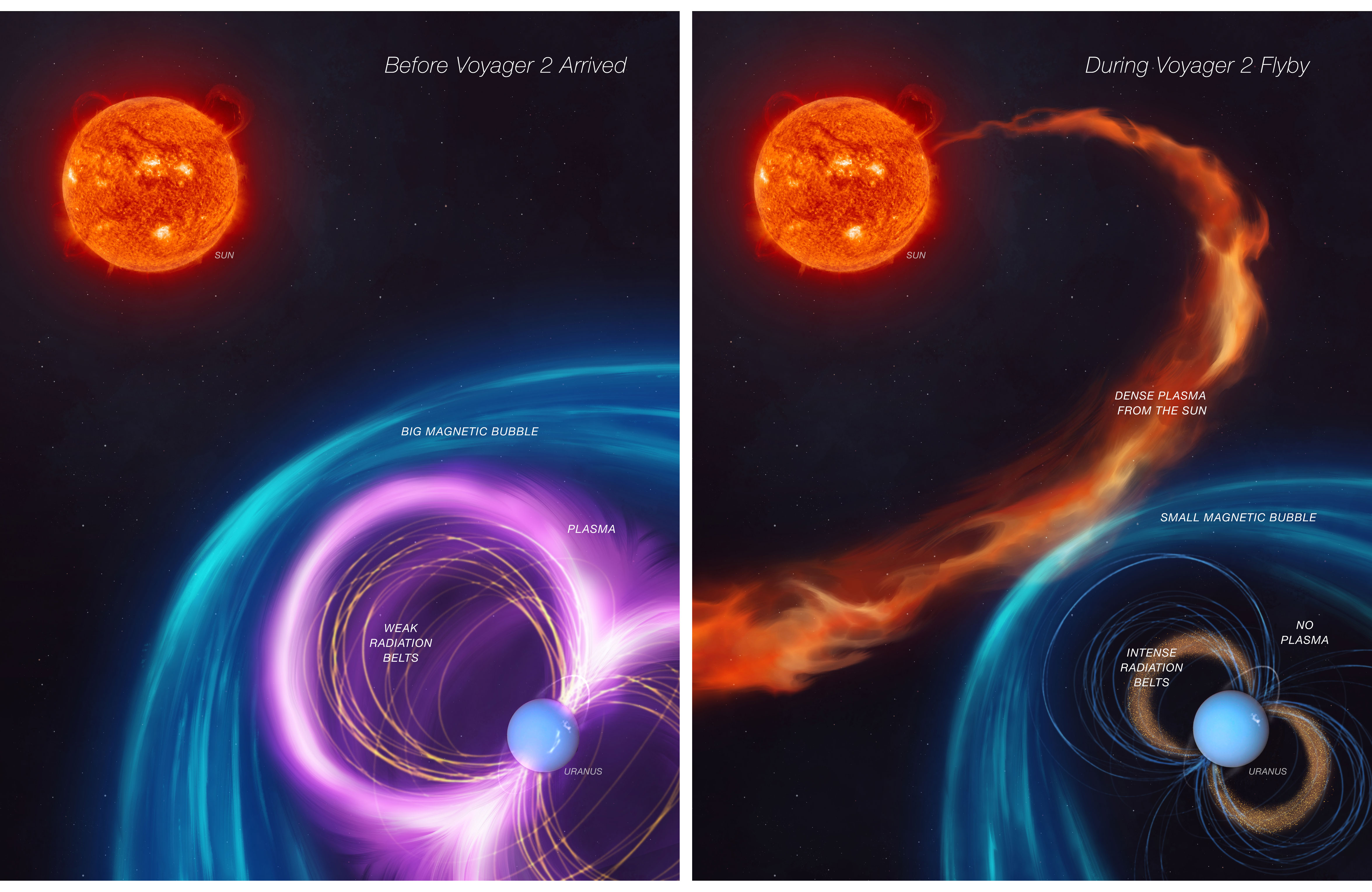Voyager 2’s visit to Uranus in 1986 occurred just after the planet was slammed by an exceptionally powerful solar outburst. The heightened solar wind compressed the magnetosphere. According to new research, we’ve been treating that squashed magnetic field as standard for 40 years, causing scientists to think the planet has several strange features that are not actually its usual state.
Humanity has sent 50 missions to Mars, but only one to Uranus and Neptune. Moreover, Voyager 2 sailed past each in just a few weeks. That brief snapshot provides most of the information we have on the ice giants. It’s natural to treat what the mission observed as typical, but if our only visit to Mars had occurred during one of its periodic planet-wide dust storms, we might be getting the Red Planet very wrong. New research builds a case the equivalent occurred for Uranus.
Life on Earth is possible because we have a magnetosphere that shields the atmosphere from the solar wind and other charged particles that would otherwise strip it away. It’s thought this is the product of currents in the Earth’s core. Exploration of the Solar System has revealed some other planets also have magnetospheres, even though the cause may not be the same, while others do not.
These magnetospheres are all unique, but Uranus’s still looked different enough from any previous planet to shock planetary scientists. Neptune’s tilted but otherwise normal magnetosphere deepened the mystery.
On the one hand, the electron radiation belts around Uranus were more powerfully charged than those of any other planet except Jupiter. On the other hand, there was no obvious source for all those highly charged electrons. The rest of the magnetosphere lacked plasma, something we have not seen anywhere else.
To deepen the mystery, the icy moons of the other giant planets leak water ions, which feed the plasma rings that form part of their magnetosphere. Uranus is not as well supplied with moons as Jupiter or Saturn, but its five largish moons, all usually inside the magnetosphere, make a better tally than Neptune’s. Surely they should be producing enough ions to maintain its plasma stocks?
Dr Jamie Jasiniski of NASA’s JPL thinks the answer is all in the timing. “If Voyager 2 had arrived just a few days earlier, it would have observed a completely different magnetosphere at Uranus,” Jasinski said in a statement. “The spacecraft saw Uranus in conditions that only occur about 4% of the time.”

Uranus was slammed by a dense plasma burst from the Sun just as Voyager 2 went past, giving us an inaccurate impression of its normal state.
Image Credit: NASA/JPL-Caltech
So far from the Sun, Uranus makes a difficult target for solar outbursts, but it still gets hit sometimes, and January 1986 was one of those, with solar wind pressure around 20 times that of normal. Jasinski and co-authors calculate the buffeting was powerful enough to drive the plasma out of the system, and Voyager 2 passed by before it had a chance to be replenished. One of the consequences of this plasma squeeze was to push electrons into the radiation belts.
The Cassini mission spent 13 years orbiting Saturn and got to study its magnetosphere in all sorts of solar wind conditions. The authors argue the magnetosphere responded to upticks in the solar wind in similar ways to those they say occurred around Uranus, but having the baseline data means we understood this wasn’t normal.
Besides removing the need to explain the apparently distinctive features of Uranus’s magnetosphere, the new research makes the planet’s moons potentially more interesting. Recently it was proposed that the innermost moon Miranda might have an internal ocean, and it’s possible the same is true for other members of the system. If this is the case, there’s hope some of that liquid sometimes escapes through fissures to the surface, as happens on Enceladus and possibly Europa.
A connection like that between an icy moon’s inner regions and space would allow future missions to collect samples and even test for life. However, if the shortage of plasma in Uranus’s magnetosphere is permanent, the moons can’t be releasing particles that would eventually settle into those belts. Testing for internal oceans would also be easier if this work is confirmed. Magnetospheres allow missions to test for the presence of electrically conductive liquids inside any objects orbiting within them. When Voyager 2 flew by the magnetosphere was so compressed two of the major moons may have been outside it, but this work suggests that is not usually the case.
The study is open access in Nature Astronomy.
Source Link: We’ve Only Been To Uranus Once And The Freak Timing May Have Misled Us For Years